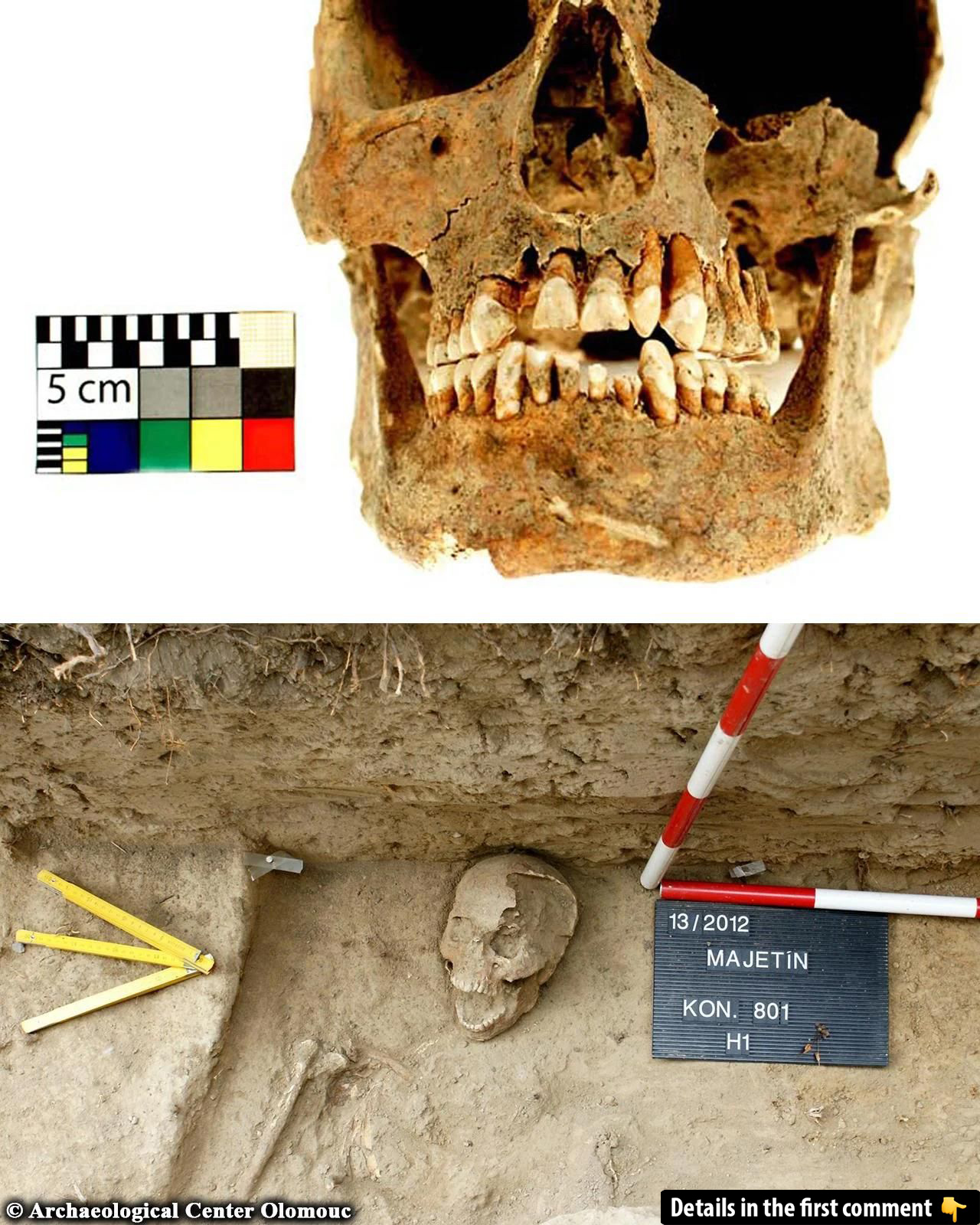A fascinating discovery has unearthed a piece of history that was previously lost to time. In the town of Majetín, Czech Republic, the remains of a 19th-century soldier have revealed the first-ever physical evidence of a long-suspected military practice: soldiers using their teeth to open gunpowder cartridges. This remarkable find not only sheds light on the soldier’s daily life but also provides an unprecedented glimpse into the physical challenges faced by infantrymen during the late 18th and early 19th centuries.
The Discovery of the Soldier’s Remains in Majetín
The skeleton of the soldier was discovered in 2012 during an excavation in Majetín, a small town in the Olomouc region of the Czech Republic. Researchers from the Olomouc Archaeological Center had been working on the site for years, but it wasn’t until nearly a decade later that they fully realized the significance of the remains they had uncovered. The soldier, believed to have been between the ages of 30 and 50 when he died, stood approximately 174 cm tall. His skeleton bore marks that told a compelling story of the physical toll exacted by military service.
While the discovery of a soldier’s remains was not in itself unusual, the details that emerged during the analysis were groundbreaking. The soldier’s teeth, particularly his lower three incisors, showed clear signs of wear and damage that pointed to a specific, repeated use of his teeth in a way that had never been conclusively proven before. This discovery was the first physical evidence confirming the practice of soldiers using their teeth to open gunpowder cartridges—a practice described in historical texts but never before observed in a skeletal analysis.
Video
Watch Scientists Discover Traces of Military Service on a 19th-Century Soldier’s Teeth to learn about this fascinating discovery. Don’t miss it!
Evidence of Gunpowder Cartridge Usage on the Soldier’s Teeth
During the 18th and 19th centuries, soldiers used paper cartridges that contained both gunpowder and bullets for their front-loading firearms. To load their weapons, soldiers had to bite into these paper cartridges to tear them open, pouring the gunpowder into the barrel and then following with the bullet. The process was quick, but it placed considerable stress on the soldier’s teeth, especially the incisors.
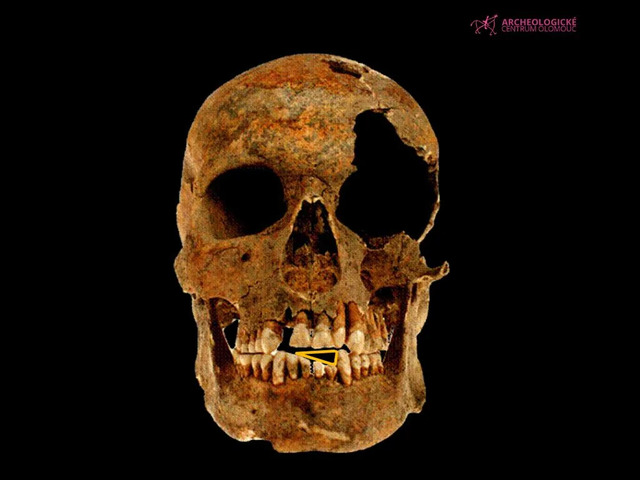
In the case of the Majetín soldier, his teeth displayed signs of mechanical damage consistent with this behavior. Anthropologist Lukáš Šín, who led the study of the remains, noted that the repeated stress of tearing open cartridges likely caused the enamel of the teeth to weaken. The soldier’s lower incisors showed signs of repeated activity, which could have eventually led to the crowns breaking under the strain. This specific damage provided the first physical confirmation of a practice that had been known from historical records, but until now, had never been confirmed through direct evidence.
Chemical Analysis and Gunpowder Traces in Dental Tartar
The breakthrough didn’t stop with the observation of dental damage. In 2017, Dr. Dana Fialová from Masaryk University performed a chemical analysis of the dental tartar on the soldier’s remains. Using X-ray spectroscopy, her team detected traces of sulfur, a key component of gunpowder. This discovery further corroborated the hypothesis that the soldier had used his teeth to handle gunpowder cartridges on a regular basis.
The presence of sulfur in the tartar not only provided evidence that the soldier had been in frequent contact with gunpowder but also suggested that his teeth had absorbed significant amounts of the substance. According to Šín, the sulfur from the gunpowder likely contributed to the deterioration of the tooth enamel, causing gingivitis and exposing the tooth bed. This chemical analysis was crucial in confirming the soldier’s involvement in the military practice of using teeth to load firearms, linking the physical damage to the chemical remnants found in his dental tartar.
Historical Context of Military Practices in the 18th and 19th Centuries
To fully appreciate the significance of this discovery, it’s important to understand the military context of the 18th and 19th centuries. During this time, front-loading firearms were the primary weapon used in military conflicts. Soldiers had to prepare their weapons for firing quickly and efficiently, often under stressful and dangerous conditions. The use of paper cartridges, which combined both gunpowder and bullets, was a standard method for loading these firearms.
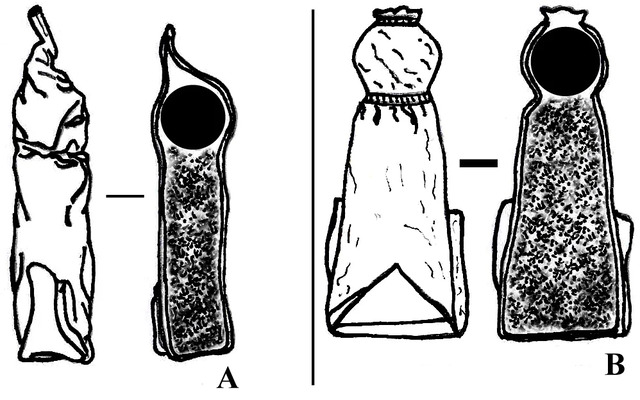
While the practice of tearing open gunpowder cartridges with teeth had been documented in military manuals and texts, physical evidence had been conspicuously absent—until the discovery in Majetín. The discovery of this soldier’s remains fills this gap, offering a tangible connection to the past and allowing historians and archaeologists to understand more clearly the daily life of soldiers during this period. The Majetín soldier’s condition offers a vivid glimpse into the physically demanding nature of military service and the unique challenges soldiers faced in preparing their weapons for battle.
The Soldier’s Physical Struggles: Impact of Military Life
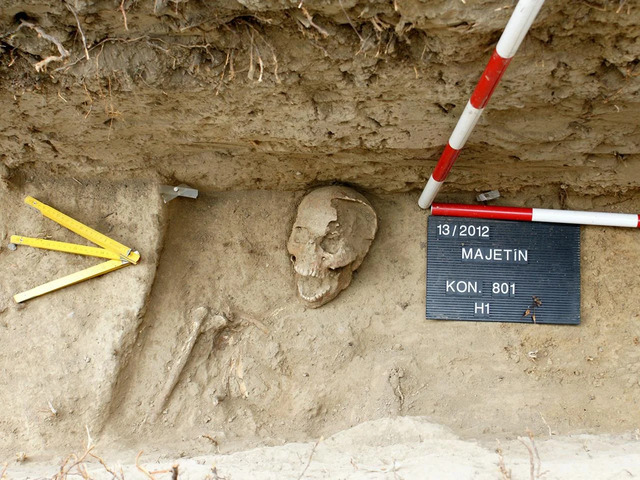
Beyond the damage to his teeth, the soldier’s skeleton provided further evidence of the toll that military life took on his body. The wear on his lumbar vertebrae suggests that he endured long, strenuous marches typical of infantry soldiers of the time. These physical stresses would have compounded the difficulties posed by his role in handling firearms and tearing open cartridges. The soldier’s body was a testament to the demanding nature of military service during the 18th and 19th centuries, where physical endurance was as crucial as the ability to engage in battle.
Global Significance of the Find: The First Documented Case
The discovery of the Majetín soldier represents the first globally recognized case of this particular military practice being confirmed through skeletal remains. While similar signs of dental damage had been noted on a battlefield at Waterloo by Belgian archaeologist Dominique Bosquet in 2012, those findings have yet to be published, making the Majetín soldier the first confirmed case in the scientific community.
This find has global significance, not only because it confirms a previously unverified aspect of military history but also because it offers new insights into the daily lives of soldiers. It sheds light on the physical and mental toll that such practices might have exacted on soldiers, who, despite facing numerous hardships, continued to engage in these dangerous routines out of necessity.
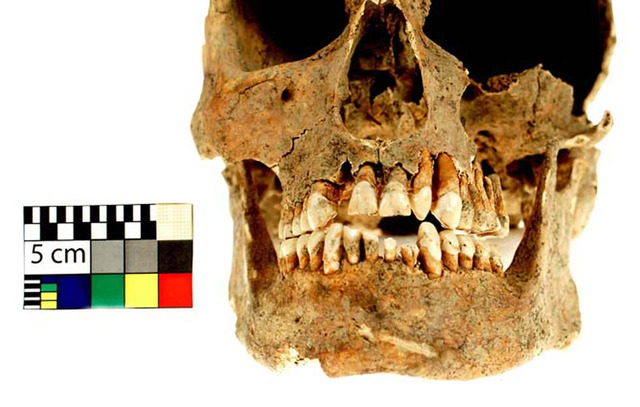
The Lasting Impact of the Majetín Discovery
The long-term research conducted on the Majetín soldier has opened new avenues of inquiry into the lives of soldiers from this period. By providing tangible, physical evidence of military practices, it has allowed archaeologists and historians to develop a more nuanced understanding of military life during the 18th and 19th centuries. The analysis of this soldier’s remains serves as a crucial piece of the puzzle in understanding the complex relationship between soldiers, their weapons, and their daily routines.
The findings from this study have been preserved and published in scientific journals, ensuring that the soldier’s legacy will continue to inform future research. As the field of military archaeology evolves, discoveries like the one in Majetín will remain a valuable resource for understanding the past.
Conclusion: The Soldier’s Legacy in Archaeology
The discovery of traces of military service on the 19th-century soldier’s teeth in Majetín offers us a rare and valuable look into the physical realities of military life during a pivotal period in history. By examining the soldier’s remains and the chemical traces of gunpowder found in his teeth, we have gained an unprecedented understanding of the hardships faced by soldiers in the 18th and 19th centuries. This discovery not only illuminates a previously unconfirmed aspect of military history but also highlights the broader implications of how archaeology can reveal the intimate details of daily life long past.
Video
Watch Little Girl Found in 19th Century Casket Identified on KTVU to uncover the mystery behind this fascinating discovery.
